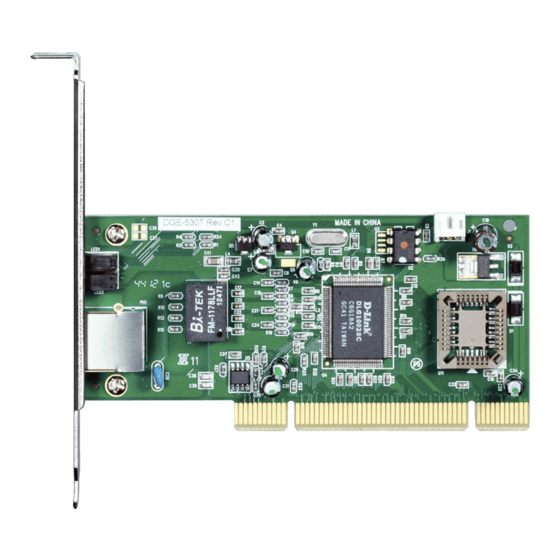
D-Link DGE-530T Quick Install Manual
Hide thumbs
Also See for DGE-530T:
- Manual (70 pages) ,
- User manual (40 pages) ,
- Quick install manual (15 pages)
Advertisement
Quick Links
Advertisement

Summary of Contents for D-Link DGE-530T
-
Page 2: System Requirements
System Requirements • A computer with an available 32-bit PCI bus master slot operating at 33MHz • Windows 2000, 2003, 2008, XP, Vista 7, Linux 2.4.x and above, ® ® or Mac OS 10.2.x and above • 150MHz processor and at least 32MB of RAM • 32MB free hard drive space • CD-ROM Drive Package Contents • D-Link DGE-530T Ethernet Desktop Adapter • Manual and Software on CD • Standard and Low Profile Brackets • Quick Install Guide If any of the above items are missing, please contact your reseller. D-Link DGE-530T Quick Install Guide... -
Page 3: Installation
Drivers for non-Windows operating systems are located on the D-Link CD. When the autorun screen appears, click Install Drivers (this will launch the Network Utility program and install the drivers). An Installation Wizard will guide you through the process, no matter which operating you are running. Your DGE-530T will be installed successfully in just a few moments, allowing you to enjoy the many advantages of joining an Ethernet LAN. D-Link DGE-530T Quick Install Guide... - Page 4 Note: Write down the serial number and hardware revision (e.g. B1) before installing the adapter. If you contact technical support, you will need this information. Replace the case, plug in the power cable, and power on your computer. D-Link DGE-530T Quick Install Guide...
- Page 5 Installation Once you boot your computer, Windows will automatically install ® the drivers. Windows XP users: You will receive a bubble stating that Windows found the DGE-530T adapter. Windows 7/Vista users: You will receive a bubble stating Windows ® ® has finished installing the DGE-530T adapter. D-Link DGE-530T Quick Install Guide...
- Page 6 Device Manager. : Click on the System and Maintenance icon and Windows Vista ® then click on Device Manager. : Click on the System and Security icon and then click Windows 7 ® on Device Manager under System. Step 3: Scroll down and click the plus (+) sign next to Network Adapters. The D-Link DGE-530T Gigabit Ethernet Adapter (rev.B) will be listed. D-Link DGE-530T Quick Install Guide...
- Page 7 Configure your Adapter Configure your Adapter After you install your new D-Link adapter, by default, the TCP/IP settings should be set to obtain an IP address from a DHCP server (i.e router) automatically. To verify your IP address, please see the following steps below. 2000/2003/XP: Click on Start > Run. In the run box type Windows ® cmd and click OK. : Click on Start > All Programs > Accessories Windows 7/Vista ® ® > Command Prompt. At the prompt, type ipconfig and press Enter.
- Page 8 Step 2: Right-click on the Local Area Connection, which represents your D-Link network adapter, and select Properties. Step 3: Highlight Internet Protocol (TCP/IP) and click Properties. Step 4: Click Use the following IP address and enter an IP address that is on the same subnet as your network or the LAN IP address on your router. Example: If the router’s LAN IP address is 192.168.0.1, make your IP address 192.168.0.X where X is a number between 2 and 99. Make sure that the number you choose is not in use on the network. Set Default Gateway the same as the LAN IP address of your router (192.168.0.1). D-Link DGE-530T Quick Install Guide...
- Page 9 Configure your Adapter Set Primary DNS the same as the LAN IP address of your router (192.168.0.1). The Secondary DNS is not needed or you may enter a DNS server from your ISP. Step 5: Click OK twice to save your settings. D-Link DGE-530T Quick Install Guide...
- Page 10 Notes Notes D-Link DGE-530T Quick Install Guide...
- Page 11 Notes Notes D-Link DGE-530T Quick Install Guide...
-
Page 12: Technical Support
6DGE530TQB04G Copyright ©2009-2010 D-Link Corporation/D-Link Systems, Inc. All rights reserved. D-Link and the D-Link logo are registered trademarks of D-Link Corporation or its subsidiaries in the United States and other countries. Other trademarks are the property of their respective owners.







